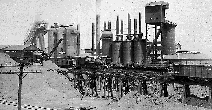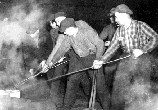![[Industrial Trail Logo]](logosmall.jpg) MADE
IN HAMILTON
MADE
IN HAMILTON20TH CENTURY
INDUSTRIAL TRAIL
![[Industrial Trail Logo]](logosmall.jpg) MADE
IN HAMILTON
MADE
IN HAMILTON
20TH CENTURY
INDUSTRIAL TRAIL
SITE
7
HAMILTON
BLAST FURNACE COMPANY, 1895
STELCO
 It
is no coincidence that Stelco and International Harvester were located cheek-by-jowl
on the waterfront. A number of American plants were attracted by Hamilton's
ready supply of primary iron and steel.
It
is no coincidence that Stelco and International Harvester were located cheek-by-jowl
on the waterfront. A number of American plants were attracted by Hamilton's
ready supply of primary iron and steel.
Hamilton became Canada's premier iron city during the 19th century. Until 1895, however, Hamilton's metal shops had to import much of their iron from out-of-town. All this changed when local foundrymen opened the Hamilton Blast Furnace Company (HBFC) on this site.
 This
company soon merged with a number of other local and regional businesses to
become Canada's largest supplier of primary iron and steel. In 1899, the HBFC
joined the Ontario Rolling Mills at the foot of Queen Street to become the Hamilton
Iron and Steel Company. In 1910, this company merged with locally-owned Canada
Screw and a number of other metal producers in Ontario and Montreal to form
the giant Steel Company of Canada (Stelco). Local 1005 of the United Steelworkers
of America presently represents close to 5000 workers at Stelco's Hilton Works.
This
company soon merged with a number of other local and regional businesses to
become Canada's largest supplier of primary iron and steel. In 1899, the HBFC
joined the Ontario Rolling Mills at the foot of Queen Street to become the Hamilton
Iron and Steel Company. In 1910, this company merged with locally-owned Canada
Screw and a number of other metal producers in Ontario and Montreal to form
the giant Steel Company of Canada (Stelco). Local 1005 of the United Steelworkers
of America presently represents close to 5000 workers at Stelco's Hilton Works.

A major strike won by Stelco workers in 1946
helped set the basis for a national system of collective bargaining. They won
union recognition, wage increases, a grievance system and other benefits. Their
gains set a standard for Canadian workers for decades to come.